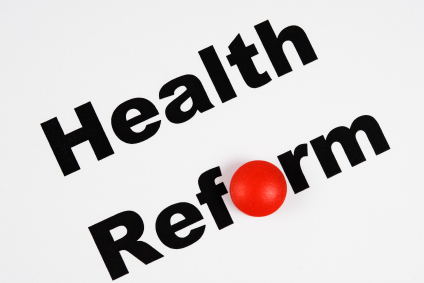After a month and a half of working through startup issues with its HealthCare.gov online health insurance marketplace, the Obama Administration turned heads by announcing on Nov. 14 that the federal government will not enforce many of the Patient Prot…
 Health care reform and the shift towards a defined-benefits model have moved voluntary benefits from the fringes of corporate benefit plans into the spotlight. Skyrocketing costs and ballooning compliance duties have pushed more employers to a tipping point, and companies are slashing or eliminating their medical plans. Those shrinking benefits, though, can crush a company’s ability to recruit and retain a top-notch workforce. To remain competitive, many employers are turning to ancillary (voluntary) products as a way to lighten the impact of reduced health care coverage and to broaden the overall appeal of their compensation package.
Health care reform and the shift towards a defined-benefits model have moved voluntary benefits from the fringes of corporate benefit plans into the spotlight. Skyrocketing costs and ballooning compliance duties have pushed more employers to a tipping point, and companies are slashing or eliminating their medical plans. Those shrinking benefits, though, can crush a company’s ability to recruit and retain a top-notch workforce. To remain competitive, many employers are turning to ancillary (voluntary) products as a way to lighten the impact of reduced health care coverage and to broaden the overall appeal of their compensation package.
Policies like flextime, corporate and social responsibility charters and voluntary benefits may become the cornerstones of your recruitment and retention strategy. In fact, United Benefit Advisors predicts, based on results from the 2013 Ancillary Products Survey, these policies will be a greater differentiator in 2014 than ever before.
In an upcoming Employee Benefit News webinar, The Hottest Voluntary Benefits for 2014, UBA CEO Thomas Mangan and Dale Alexander of Alexander & Company, a UBA Partner Firm, will explain the significance of this shift and how businesses can use voluntary benefits to their maximum advantage.
The presentation will cover:
The webinar will take place on Tuesday, Nov. 19, 2013 at 2 p.m. ET/11 a.m. PT and will feature a live Q&A. Click here to register.

While there have been delays on some key provisions of PPACA, employers will need to start planning now to ensure compliance in 2015.
Forthcoming changes to the insurance market landscape in 2014 and 2015 will bring many employers to a crossroad.
 The IRS does not consider the availability of the health exchanges/marketplaces a change in status event that would allow an employee to make a mid-year change under a Section 125 plan. However, the IRS has said that it will allow an employer with a non-calendar year plan to amend the plan to allow employees to make mid-year election changes to move from the plan to the marketplace, to allow employees who previously declined coverage to enroll in the plan as of Jan. 1, 2014, or both. (Because coverage purchased in the marketplace will be effective Jan. 1, 2014, calendar year plans should not have this issue.) There had been some question about whether this option was only available to large employers; the IRS has now clarified that employers of all sizes may amend their plan to allow for mid-year changes because of the new marketplace coverage.
The IRS does not consider the availability of the health exchanges/marketplaces a change in status event that would allow an employee to make a mid-year change under a Section 125 plan. However, the IRS has said that it will allow an employer with a non-calendar year plan to amend the plan to allow employees to make mid-year election changes to move from the plan to the marketplace, to allow employees who previously declined coverage to enroll in the plan as of Jan. 1, 2014, or both. (Because coverage purchased in the marketplace will be effective Jan. 1, 2014, calendar year plans should not have this issue.) There had been some question about whether this option was only available to large employers; the IRS has now clarified that employers of all sizes may amend their plan to allow for mid-year changes because of the new marketplace coverage.
The IRS has delayed the individual shared responsibility requirement for individuals who are eligible for coverage under an employer-provided non-calendar year group health plan to the start of the employer’s 2014 plan year, so obtaining coverage by Jan. 1, 2014, is not as urgent as previously thought. Employers may still wish to allow employees to enroll in their plan mid-year, and with the required plan amendment (most likely to both the Section 125 and group health plans) this will be allowed. An employer considering a mid-year enrollment option may want to get the approval of its insurer or reinsurer before offering this opportunity – insurers are not required to allow mid-year enrollment.
Download the complete UBA summary of this notice called “IRS Liberalizes the Health Flexible Spending Account ‘Use it or Lose It’ Rule” here.
Read the full text of IRS Notice 2013-71.

 By Josie Martinez, Senior Partner and Legal Counsel
By Josie Martinez, Senior Partner and Legal Counsel
EBS Capstone, A UBA Partner Firm
Most of us are scratching our heads on a daily basis as the rules of health care reform seem to shift continually. Particularly for employers in the under 50 employee market, identifying marketplace health care coverage options has been a moving target. Currently, it seems small groups have five viable options: 1) state exchanges; 2) SHOP exchange; 3) private exchanges; 4) co-operatives and 5) going direct to carriers.
The first option seems relatively simple: direct employees to the marketplace in the state where they reside to purchase individual coverage. Keep in mind that the exchanges are state-specific, so there will be variations in benefits and network access based on that particular state’s offerings — something to consider if a small employer has employees in different states.
The second option, the SHOP exchange, is a good coverage alternative for employers with 50 or fewer employees if certain requirements are met. In Massachusetts, for example, employers participating in SHOP must contribute at least 50 percent of the premium amount. In addition, employers with 1-5 employees must have 100 percent of the employees enrolled; and employers with 6-50 employees must have at least 75 percent of the employees enrolled. For some employers, a SHOP exchange may offer the additional advantage of certain tax credits.
Private exchanges appear to hold great promise, but many are still under development or may limit plan offerings to the options available from a single carrier. On the other hand, development in this area has been rapid — witness the recent availability of the UBA Exchange Marketplace option for small employers, called benefitbay™. Benefitbay can be an option for employers because it provides an enrollment and administration process, and allow them to offer their workers the advantages of large group medical and ancillary insurance benefits with multiple carriers, while allowing subsidy-eligible employees to go to government exchanges. In the “defined contribution” model prevalent with private exchanges, employers benefit from fixed costs by choosing how much they will contribute to an employee’s health plan — a strategy gaining popularity for its ability to control benefits expenses.
It is certainly worth keeping an eye on the private exchange market in order to better advise small group clients.
Finally, the last two options — co-ops and going direct to the carriers — are the traditional modes for purchasing employee health coverage. Still viable options, these methods of providing health insurance remain the most popular coverage choices for most small employers.
A critical issue for employers to consider when deciding what option works best for their small business is the tax status of contributions. After Dec. 31, 2013, employer contributions for individual health insurance coverage are taxable to the employee as regular compensation and subject to income tax and FICA tax. For the employer, any such contribution may be a tax deduction as a business expense, but the employer must still pay FICA taxes. From the employee’s perspective, employer contributions for health coverage are tax free only if they go towards a group plan. In addition, any payment by an employee for the purchase of individual coverage through a public or private exchange must be paid with post-tax dollars (although premium costs in excess of 10 percent of income may be deductible on the employee’s tax return). These tax consequences are key considerations for any small employer grappling with the healthcare options for its employees down the road.

When the Affordable Care Act first passed, most self-insured employers thought they wouldn’t need to pay much attention to the new health insurance exchanges (or marketplaces) created by the law.

By Josie Martinez, Senior Partner and Legal Counsel
EBS Capstone, A UBA Partner Firm
First, Friday the 13th and then Halloween… Coincidence, or does the IRS have a peculiar sense of humor given the dates of its recent rulings? Regardless, there was breaking news on Oct. 31 when the IRS announced a change to the long-standing Health FSA “Use-It-or-Lose-It” rule. This important change allows Section 125 Health FSAs to be amended to allow up to $500 of unused amounts remaining at the end of the Health FSA plan year to be carried over to reimburse medical expenses incurred during the following plan year. The $500 carryover amendment may be adopted for the health FSA only; it is not available for Dependent Care FSAs. Also, the carryover of up to $500 does not affect the $2,500 maximum salary reduction that the participant is permitted to elect to a health FSA.
It is important to note that the new carryover rule can only be adopted by Health FSAs that do not also incorporate the “grace period rule” — the rule which has traditionally allowed expenses incurred within the two and one half months following the end of the plan year to draw down an account balance existing at the end of the prior plan year. The new carryover rule is an alternative to the current grace period rule. So, if an employer is deciding which rule to implement, keep in mind that there is no limit on the amount carried over in the grace period, but the money must be used within two and one half months – whereas the carryover is indefinite in duration, but limited to $500. The bottom line is that neither provision completely eliminates the chance of forfeiture.
A few important things that employers should keep in mind:
Finally, should an employer decide to amend their FSA to adopt the new carryover rule, it should be prepared to communicate the change to employees. Employee communications will be particularly important where the plan switches from the grace period to the carryover to ensure employees understand the limits of the carryover. Redistribution of health FSA Summary of Plan Descriptions (SPDs) may also be in order.

 On Sept. 13, 2013, the IRS issued details on permissible health reimbursement arrangements(HRAs), providing some clarification on minimum essential, minimum value and affordable coverage, and addressing payment of individual premiums through an employer-provided plan.
On Sept. 13, 2013, the IRS issued details on permissible health reimbursement arrangements(HRAs), providing some clarification on minimum essential, minimum value and affordable coverage, and addressing payment of individual premiums through an employer-provided plan.
Most people had expected that standalone HRAs would have difficulty meeting PPACA’s prohibition on dollar limits, and the Notice confirms this. Beginning with the 2014 plan year, an HRA will not be permitted unless:
In order for an HRA to be integrated:
United Benefit Advisors developed a full summary on this guidance, which includes additional information on the following:
* Grandfathered plans are not required to provide first dollar coverage for preventive care.

 Peter Freska, CEBS
Peter Freska, CEBS
Benefits Advisor
The LBL Group, A UBA Partner Firm
It is finally here. The Patient Protection and Affordable Care Act (PPACA), along with all the “stuff” that has been following it is really happening. Of course, with any major change there are bumps along the way. Apple had a bump with it new iOS7, and was able to respond and issue an update to fix the problems in short order. Perhaps the only difference is that Apple employees are still working… Okay, in fairness, so are the health care reform exchange employees.
So what about the employees of your company? The latest tracking polls from the Kaiser Family Foundation (source: http://kff.org/health-reform/) indicate that the public’s top two questions about health care reform are:
With information coming at employees from all angles, it is hard to know what to believe, let alone what parts need to be understood. More and more, employers are looking to their trusted advisors to help answer their employees’ questions. With 49 percent of the United States receiving employer-based health coverage, looking to their employers is the obvious choice.
| Location | Employer | Individual | Medicaid | Medicare | Other Public | Uninsured | Total |
| United States | 49% | 5% | 16% | 13% | 1% | 16% | 100% |
Source: http://kff.org/other/state-indicator/total-population/
So as an employer, the question becomes how to respond. As with most things, communication, communication, communication is the key. Employers and employees need to communicate. And, if they don’t know the right answer both should look to their trusted advisor as the best educated resource to the right answer. Here are 10 tips from the International Foundation of Employee Benefits to assist with communicating the health care reform law to your employees.
Source: http://www.ifebp.org/News/FeaturedTopics/HCRC/acahowto.htm
